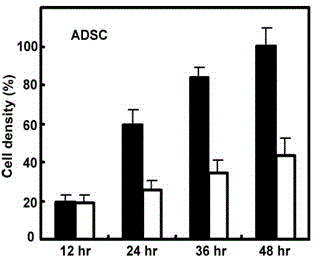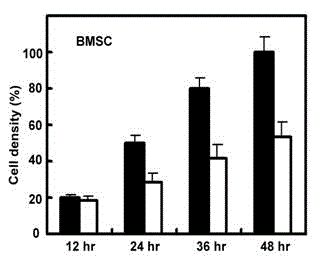Stem cell culture medium and application thereof and stem cell cultivation method
A stem cell and culture medium technology, applied in the field of cell culture, can solve the problems of increase and decrease of cell potential passage times, slow growth of stem cells, etc.
- Summary
- Abstract
- Description
- Claims
- Application Information
AI Technical Summary
Problems solved by technology
Method used
Image
Examples
Embodiment 1
[0182] Example 1. Acceleration of stem cell proliferation
[0183] The conventional medium formula for culturing stem cells is: DMEM / F12 basic medium, 10% fetal bovine serum (FBS). In order to compare the culture medium described in the present invention and to examine the influence of the culture medium described in the present invention on the expansion speed of human stem cell culture, human stem cells from three kinds of tissue and organ sources: fat, bone marrow and umbilical cord were selected in this example. (ADSC, BMSC, UMBSC) for in vitro cell culture experiments. The cell seeding density is controlled between 10-20%. Before seeding, the culture dish is treated with cell adhesion material at room temperature for 2 hours or incubated overnight at 4°C. After seeding, culture medium is added (37°C, 5% CO 2 ). Cell density was measured every 12 hours by the MTT assay. The test results are shown in Figure 1~ image 3 As shown, the stem cells (solid column) cultured in...
Embodiment 2
[0184] Example 2. Potential analysis of proliferating mesenchymal stem cells into chondrogenic cells in vitro
[0185] In order to examine the influence of stem cells on their differentiation potential after being amplified by the medium described in the present invention for 10 generations, human stem cells derived from fat, bone marrow and umbilical cord were measured in this example according to the method described in the literature ( ADSC, BMSC, UMBSC) after expansion of chondrogenic differentiation assay (Estes BT et al. Nat Protocol 2010; 5 : 1294–1311; Awad HA et al., Biomaterials. 2004 Jul;25(16):3211-22; Cheng NC et al., Tissue Eng Part A. 2009 Feb;15(2):231-41). When the stem cells grow to a suitable density (cell density 20-80%), add chondrogenic induction medium (DMEM / F12 medium with 1% FBS, 10 mg / L TGF-β1, 50 nM vitamin C, 6.25 mg / L insulin , 1% double antibody), the medium was changed once a day, and the total induction was 2-3 weeks. Alcian blue staining w...
Embodiment 3
[0186] Example 3. Potential analysis of adipogenic cells
[0187]In order to further examine the influence of stem cells on their differentiation potential after being amplified by the medium described in the present invention for 10 generations, in this example, we followed the adipogenic induction and oil red O staining methods of adipose-derived stem cells (ADSC) described in the literature. The differentiation experiment of adipocytes after the expansion of human stem cells (ADSC, BMSC, UMBSC) derived from fat, bone marrow and umbilical cord three kinds of tissues and organs was measured according to the method described in the literature (Yu G et al., Methods in Molecular Biology, 2011, Volume 702, Part 3, 193-200; Bunnell BA et al., Methods. Volume 45, Issue 2, June 2008, Pages 115–120; Gimble JM & Guilak F. Cytotherapy. 2003, Vol.5, No. 5, Pages 362-369). The specific method is, when the stem cell density is about 80%, replace it with adipogenic medium for induction. ...
PUM
 Login to View More
Login to View More Abstract
Description
Claims
Application Information
 Login to View More
Login to View More - R&D
- Intellectual Property
- Life Sciences
- Materials
- Tech Scout
- Unparalleled Data Quality
- Higher Quality Content
- 60% Fewer Hallucinations
Browse by: Latest US Patents, China's latest patents, Technical Efficacy Thesaurus, Application Domain, Technology Topic, Popular Technical Reports.
© 2025 PatSnap. All rights reserved.Legal|Privacy policy|Modern Slavery Act Transparency Statement|Sitemap|About US| Contact US: help@patsnap.com



